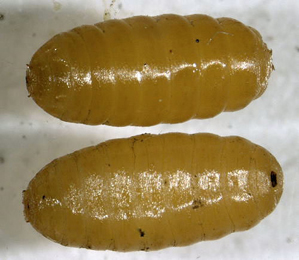|
||||||
|
Trypeta artemisiae (Fabricius, 1794) Musca
artemisiae Fabricius, 1794. Entom. syst. 4:
351 |
|||||||||||||||||||||||||||||||||||||||||||||||||||||||||||||||||||||||||||||||||||||||||||||||||||||||||||||||||||||||||
|
Leaf-miner: The mine begins as an elongated blotch overlying a strong vein; from there broad tunnels radiate that coalesce in the end. All frass is concentrated at a central point in the floor of the mine. As a result the mine has a brownish-black centre and a paler brownish green seam. The larva often (perhaps always at daylight) rests in the centre of the mine. Primary and secondary feeding lines as a rule quite clear. Pupation outside the mine (Bladmineerders van Europa). An elongated blotch centred over a vein. There are two types: greenish with a blackish centre and entirely reddish-black (British leafminers). Larva: The larvae of flies are leg-less maggots without a head capsule (see examples). They never have thoracic or abdominal legs. They do not have chewing mouthparts, although they do have a characteristic cephalo-pharyngeal skeleton (see examples), usually visible internally through the body wall. The larva is illustrated in Bladmineerders van Europa and British leafminers. Puparium: The puparia of flies are formed within the hardened last larval skin or puparium and as a result sheaths enclosing head appendages, wings and legs are not visible externally (see examples). Yellow; anterior spiracle openings arranged in large arcs, not elevated on a fan-shaped structure; posterior spiracles each with a central opening larger and more raised than the lateral openings (White, 1988: 63). The puparium is illustrated in Bladmineerders van Europa.
Comments: Uffen in Chandler (1978) did not indicate whether his host records were British of Foreign and therefore the associations are included under 'Host in Britain' and 'Hosts elsewhere'. Hosts in Great Britain and Ireland:
Hosts elsewhere: Time of year - mines: September-October. Time of year - adults: ? June. Distribution in Great Britain and Ireland: Throughout Britain, more common in the north than in the south (White, 1988: 63) including Warwickshire (Packington) (Robbins, 1991: 119); Bedfordshire, Berkshire, Cambridgeshire, Cheshire, Denbighshire, Dorset, Durham, East Gloucestershire, East Sutherland, Glamorgan, Leicestershire, Mid-west Yorkshire, Monmouthshire, North Hampshire, Shropshire, South Hampshire, SouthLancashire, South-east Yorkshire, South-west Yorkshire, Stafford, Surrey, West Lancashire and Westmorland (NBN Atlas). Distribution elsewhere: Throughout the Palaearctic Region, except the Mediterranean and Middle Eastern areas (White, 1988: 63), including The Netherlands, Luxembourg (Bladmineerders van Europa) and Belgium (Leclercq and de Bruyn, 1991). See also Pape & Beuk. See also Fauna Europaea. NBN Atlas links to known host species: British and Irish Parasitoids in Britain and elsewhere:
|
| Last updated 10-Jul-2019 Brian Pitkin | ||

